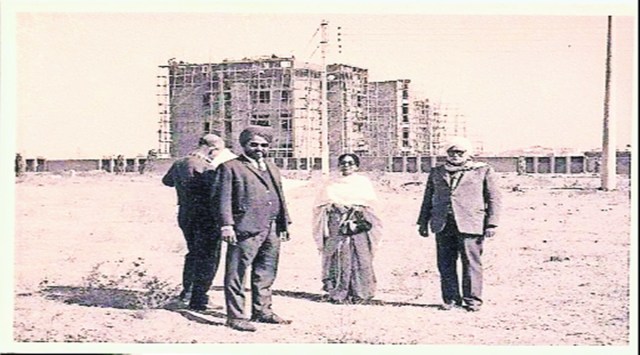- India
- International
How Shanti Niketan and Vasant Vihar came up for retd central govt officers
The colony of Shanti Niketan, lying close to the diplomatic enclave of Chanakyapuri, was built on the request of a few government servants, for allotment of some land at a subsidised rate for their post-retirement years.
 Milly Murgai’s parents taking possession of land in Vasant Vihar. Milly Murgai
Milly Murgai’s parents taking possession of land in Vasant Vihar. Milly MurgaiIn the mid-1950s when Padma Chib (85) reached Japan with her husband after a 26-day journey on the ship from Calcutta, she received a letter from her father-in-law who was in Chandigarh at that time, informing them about a central government servants’ cooperative housing society being formed in Delhi. Her husband, Ashok Sen Chib, was in the foreign services at the time and was, therefore, eligible to apply for membership to the society, which would entitle him to a plot of land close to Shanti Path.
“We were too young at that time and buying a piece of land was not in our priorities at all. But we thought it was a good idea to invest for the family to settle in the future,” recollected Chib. Her husband immediately filled up the form and sent it back to India. Thereafter, her father-in-law made the initial payments for buying the land on what became Shanti Niketan, where her home stands today.
The colony of Shanti Niketan, lying close to the diplomatic enclave of Chanakyapuri, was built on the request of a few government servants, for allotment of some land at a subsidised rate for their post-retirement years. Consequently, as more and more government employees showed interest in buying land here and not enough space available, the project moved into the nearby Basant village, which later became the colony of Vasant Vihar.
Chib, who has been researching the history of Shanti Niketan, explained that the initial idea was proposed by three or four mid-level officers of the Ministry of Home Affairs. “The idea found favour particularly among those officers who had moved to Delhi after the Partition and had lost out on their land and property,” explained Chib. Later, the group realised the possibility of being allotted better and more land if they came together as a cooperative housing society of all central government officers.
They zeroed in on large tracts of barren farmland adjoining Shanti Path. “Many of the officers were not happy about it, since it was so far away from the main city. However, once Chanakyapuri was born as a diplomatic enclave close by, it convinced many to invest in land here,” said Chib.

She recalled that at that time, most officers interested in buying land here were close to their retirement age, and were looking for income opportunities for the later part of their lives. “They knew that given the close proximity to the diplomatic enclave meant that employees in the embassies would require housing near their working place.”
Consequently, 192 plots of land were purchased by the government employees in Shanti Niketan. Once land fell short here, the cooperative society moved to the Basant village close by. Milly Murgai (66), whose father purchased land in Vasant Vihar in the early 1960s, said that she has vivid recollections of visiting a dusty small hillock close to Shanti Path as a young adolescent. Her father pointed in the far distance saying that he would be building their house there. “My siblings and I were horrified. There was not a single tree or house around,” said Murgai, who is secretary of the Vasant Vihar Welfare Association. “For that generation, building a house was the single most important achievement.”
Given how dear the idea of owning a house was, the residents recollected how personally involved they all were in planning the design, and laying bricks and mortar to build their beloved homes. Santosh Manchanda (94) said she would travel down to Vasant Vihar every day from the government quarters of Alipur Road in Old Delhi where she was living at that time, to personally monitor the building of her home. “I did not like the original plan designed by the architects, so I drew it up by myself,” said Manchanda, who is also an acclaimed artist and was married to an IAS officer in the Planning Commission. “I would sit out and paint all day long while the builders worked. Over time, I became friends with them and we would chat and sing together as well,” she recalled.
Given that the earliest residents of Vasant Vihar were retired and had more time for leisure, a kind of friendship and camaraderie developed among them, in stark contrast to many other South Delhi colonies. Manchanda recollected how the entire colony was like one big family, celebrating all big and small occasions together. Of particular interest were the gardening competitions in which the women of the households were very closely involved.
“Mrs Krishna Kheda who stayed here would give us all gardening lessons. Then there was another neighbour, a keen gardener, who taught us how to make bonsais,” she remembered.
Those who were still in service and posted outside of Delhi would often rent out their houses till they retired. Given the proximity of Chanakyapuri, the most popular tenants were the embassies and their employees. The Manchandas, for instance, had rented their house to the British High Commission before they moved in. At present, there are close to 59 Embassies in Vasant Vihar including that of Ukraine, Costa Rica, Venezuela, Senegal and others.
With time and as the newer generation moved into the neighbourhood, the strong community bonding faded away. “Since we were all more tied up with our work, our generation did not get so involved with the community,” said Ajan Manchanda, son of Santosh Manchanda. He was quickly interrupted by his mother, who said, “People keep saying that Vasant Vihar has changed. But for me, it is still the same. There is no place in Delhi like this place. I love Vasant Vihar.”
Must Read
Apr 23: Latest News
- 01
- 02
- 03
- 04
- 05




































